- Reference Number: HEY1197/2020
- Departments: Emergency Department, Physiotherapy
- Last Updated: 31 December 2020
Introduction
This leaflet has been produced to give you general information about how to use elbow crutches. You have been provided with elbow crutches to help you walk safely whilst allowing you to protect the injured leg. It will take a little time to get used to the crutches and so it is important you try not to rush.
Your clinician will advise you on whether you can put weight through the affected leg whilst using the crutches; this will depend on the type of injury you have sustained. It is very important you follow this advice to give you the best chance of recovery.
The section below give a step by step guide to how to use the elbow crutches depending on what weight you are allowed to put through the affected leg.
What is the correct crutch height?
| The clinician you see will ensure the elbow crutches are the correct height for you. It is important you do not adjust this height as it may affect your posture and lead to pain elsewhere.
The picture illustrates that the crutch handle should be just above the wrist crease, level with the prominent ulna bone. |
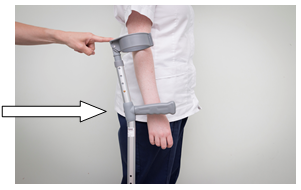 |
Sitting and Standing
To ensure you do not injure your shoulders or elbows it is important you stand up and sit down following the advice below.
Standing up
- Place one hand on the chair arm
- At the other side place the crutches in a H shape in front of your leg and place your other hand on the crutch handles
- Push yourself up into standing
- Once standing, place one arm in the cuff of one of the crutches and, again, hold both crutch handles while you let go with the other hand and put this arm into the cuff
- Now move the crutches into a walking position either side of the legs
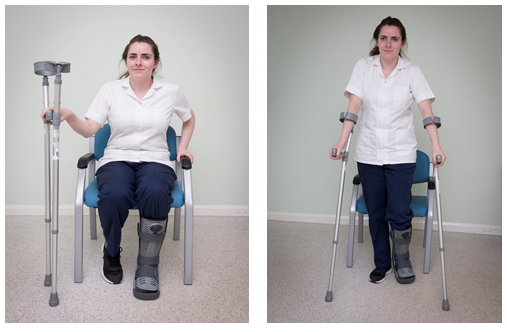
Sitting down
- Ensure the chair is lined up right behind you
- Put both crutches together at one side of your body making the H shape as you did to stand up
- Take one arm out and take hold of the crutch handles while you remove the other arm and place this on the crutch handles
- Put the free arm on the chair to ensure it is stable for you to sit on and lower yourself down
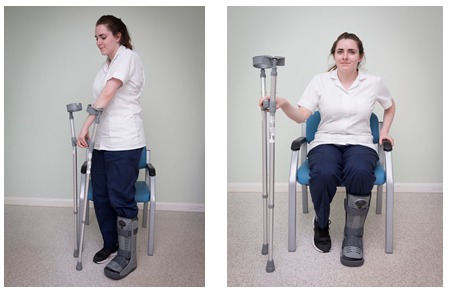
Non-Weight Bearing
Non-weight bearing (NWB) means you should not put any weight through the affected leg when attempting to stand, walking with the crutches or sitting down
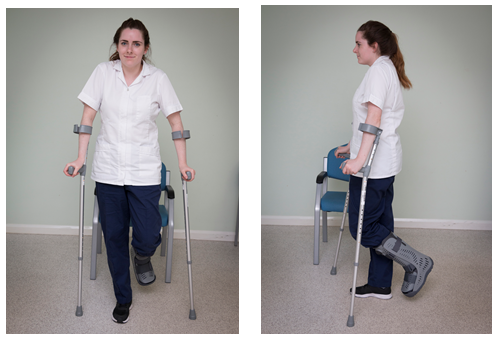
- Stand up on the unaffected leg keeping your affected foot off the floor
- Once in standing place both crutches one step in front of you, level with each other and bend the knee of your affected leg to ensure it stays off the ground.
- Hop forwards with your unaffected leg so that your body is level or just behind the crutches
- Steady yourself and repeat
Toe touch weight bearing
Toe touch weight bearing (TTWB) means the tips of your toes can rest on the floor but you still should not put any weight on them when attempting to stand, walking with crutches or sitting down.
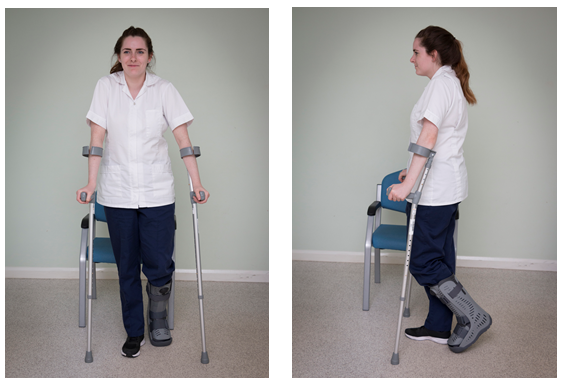
- Use the same technique as for NWB but instead of holding your knee bent, let the toes of your affected leg touch the floor
Heel weight bearing
Heel weight bearing (HWB) means you can place weight through your heel only when standing, walking with crutches or sitting down
- Stand up on the unaffected leg keeping the weight through the affected heel only
- Once standing, place both crutches one step in front of you, level with each other.
- Put the affected leg forward first striking the heel to the floor, level or just behind the level of the crutches. Ensure you keep your toes off the floor
- Now put weight through your crutches and bring the unaffected leg level with affected leg
- Steady yourself and repeat
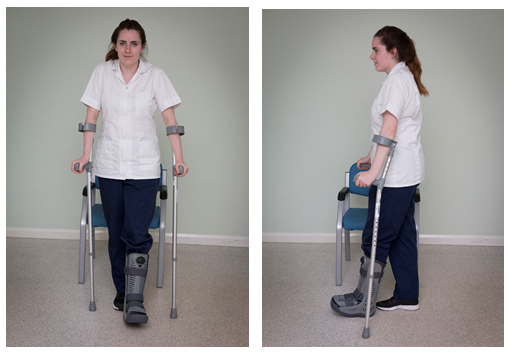
Partial weight bearing
Partial weight bearing (PWB) means that you can put some weight on your affected leg; you will have been advised how much by the clinician that you saw.
- Stand up with weight on both feet but favouring your unaffected side.
- Once standing, place both crutches one step in front of you, level with each other.
- Put the affected leg forward first striking the heel to the floor, level or just behind the level of the crutches.
- As you transfer your weight to the toes of your affected leg, put weight through your crutches and then bring the unaffected leg level with affected leg.
- Steady yourself and repeat
- See photographs on the next page
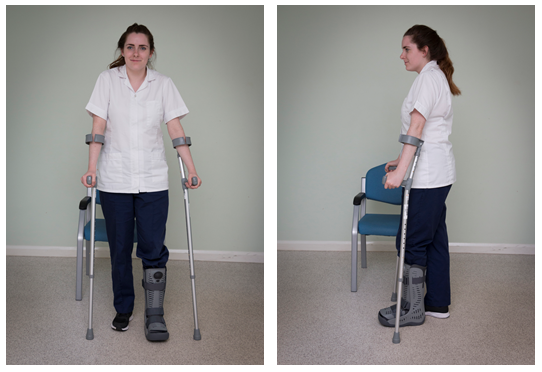
Full weight bearing or weight bearing as tolerated
Full weight bearing (FWB) or weight bearing as tolerated (WBAT)
- Stand up with equal weight on both feet.
- Once standing, place both crutches one step in front of you, level with each other.
- Put the affected leg forward first striking the heel to the floor, level or just behind the level of the crutches. Take as much weight on your affected leg as you can.
- As you transfer your weight to the toes use the crutches to prevent you limping and bring the unaffected leg level with affected leg
- Steady yourself and repeat
- The photographs above for partial weight bearing also demonstrate this technique
Progressing to one crutch
When fully weight bearing or weight bearing as tolerated, it is possible for you to progress to one crutch to help you walk, if you feel able to do so. There are some photographs over the page to demonstrate the process.
- Stand up with the crutch on the side of the unaffected leg
- Once standing, place the crutch one step in front of you to the side of your unaffected leg
- Put the heel of the affected leg level or just behind the level of the crutches.
- As you take weight on to the toes of the affected leg put some weight on the crutch and step the unaffected leg through
- Repeat the process
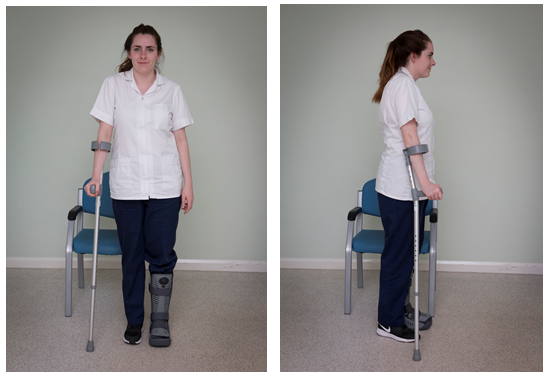
Note: Your walking pattern should be as normal as possible using one crutch. If you find that you are leaning heavily on the crutch it may be that you are not ready to progress to one crutch as yet.
Stairs
When climbing the stairs you should follow the pattern below:
- Stand close to the handrail and hold with one hand. Use one crutch in the other hand.
- Step or hop up with your good leg first, supporting the affected leg with the handrail and the crutch
- Now bring your affected leg up onto the step (if you are non-weight bearing do not put weight through this leg) followed by the crutch
- Ensure the crutch is firmly on the step so that it cannot slip back off the edge.
- Repeat until you reach the top
- If there is no handrail available, keep your crutches with one either side of your body
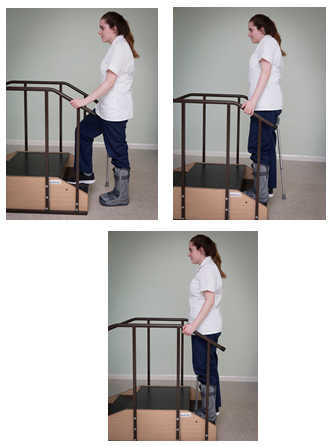
When coming down the stairs you should follow the pattern below:
- Stand close to the handrail and hold with one hand. Use one crutch in the other hand.
- Firstly put the supporting crutch down onto the next step first, ensure the crutch is firmly on the step so that it cannot slip forward off the edge.
- Now using the support of the handrail and the crutch put your affected leg down towards the same step (if you are non-weight bearing do not put weight through this leg)
- Lastly, step or hop the unaffected leg down onto the same step as the affected one
- Repeat until you reach the bottom
- If there is no handrail available, use your crutches with one either side of your body
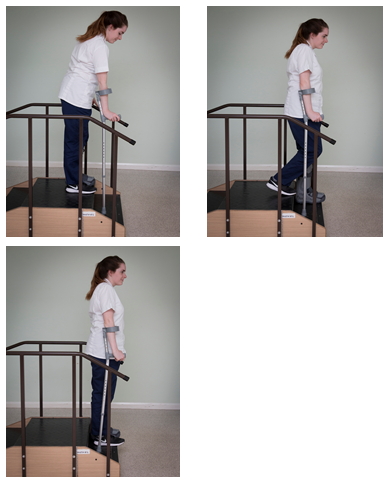
Carrying the second crutch up and downstairsIf you have someone available to you it is usually easier if they carry the second crutch up or down the stairs for you If this is not possible you can hold the second crutch in the same hand as the supporting crutch by making a cross with it at the handle |
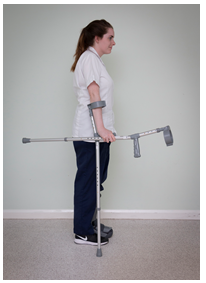 |
General Safety
Safety checks you should complete regularly:
- Check the rubber ends on your crutches regularly for signs of them wearing smooth.
- Check that all the gold or silver buttons on your crutches (that adjust the height of the crutches) are sticking firmly out of the metal and are not pushed in.
- Also check for any other signs of wear on the handles, cuffs or crutch poles themselves
- If any of these issues are noted then this could affect your safety and you should contact the department in which you are currently under the care of for this injury as soon as possible. This may be the physiotherapy department or fracture clinic if you have not yet been referred to a physiotherapy team.
Other safety tips
- Only use the crutches as you were instructed by the physiotherapists
- Ensure you wear well fitted full shoes or slippers where able
- Remove all obstacles including rugs and other trip hazards around the home
- Take care in wet or icy conditions
- Take care when carrying bags. A rucksack worn over both shoulders is the safest way to carry anything you need as this will ensure you are equally balanced
Who to contact if you have any further questions
If you have any problems with your crutches or have any queries then please contact the department in which your crutches were issued using the switchboard telephone line tel: 01482 875875.
If you have been referred on to a physiotherapy service for further assessment and treatment you can discuss any issues with the relevant physiotherapy team.
Community Physiotherapy Services
Hull GP tel: 01482 300003
East Riding GP tel: 01377 208300
General Advice and Consent
Most of your questions should have been answered by this leaflet, but remember that this is only a starting point for discussion with the healthcare team.
Consent to treatment
Before any doctor, nurse or therapist examines or treats you, they must seek your consent or permission. In order to make a decision, you need to have information from health professionals about the treatment or investigation which is being offered to you. You should always ask them more questions if you do not understand or if you want more information.
The information you receive should be about your condition, the alternatives available to you, and whether it carries risks as well as the benefits. What is important is that your consent is genuine or valid. That means:
- you must be able to give your consent
- you must be given enough information to enable you to make a decision
- you must be acting under your own free will and not under the strong influence of another person
Information about you
We collect and use your information to provide you with care and treatment. As part of your care, information about you will be shared between members of a healthcare team, some of whom you may not meet. Your information may also be used to help train staff, to check the quality of our care, to manage and plan the health service, and to help with research. Wherever possible we use anonymous data.
We may pass on relevant information to other health organisations that provide you with care. All information is treated as strictly confidential and is not given to anyone who does not need it. If you have any concerns please ask your doctor, or the person caring for you.
Under the General Data Protection Regulation and the Data Protection Act 2018 we are responsible for maintaining the confidentiality of any information we hold about you. For further information visit the following page: Confidential Information about You.
If you or your carer needs information about your health and wellbeing and about your care and treatment in a different format, such as large print, braille or audio, due to disability, impairment or sensory loss, please advise a member of staff and this can be arranged.

